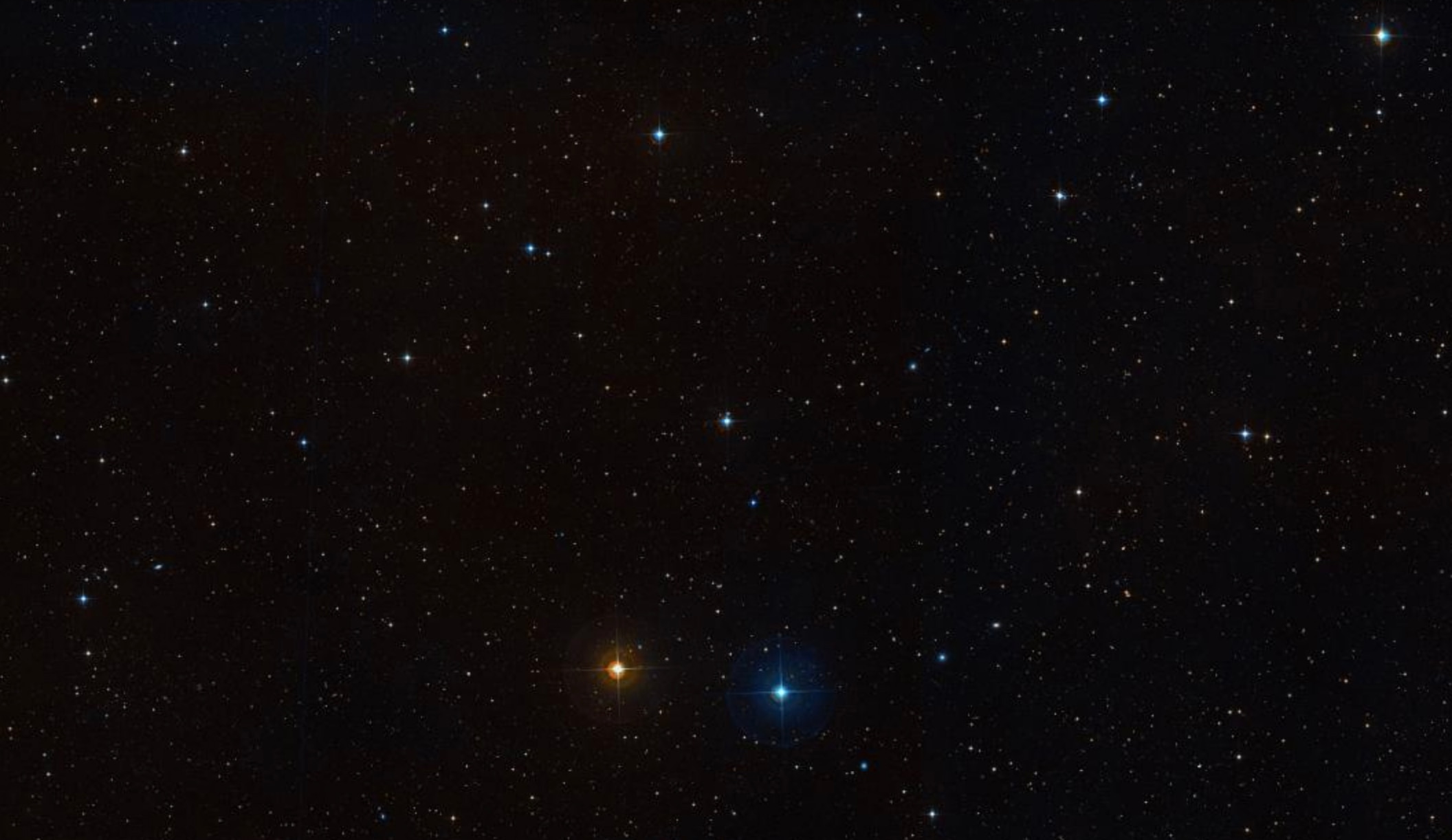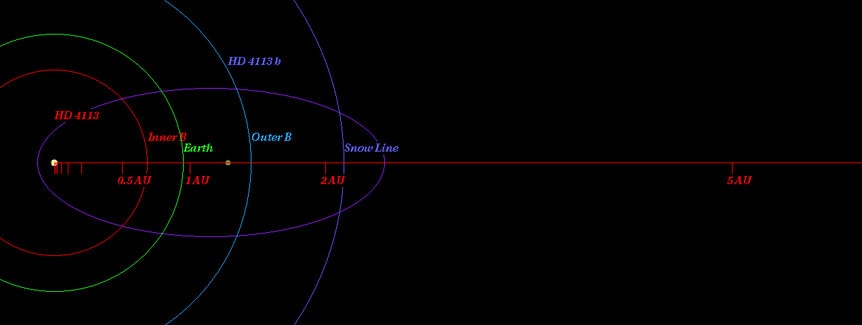Create a free profile to get unlimited access to exclusive videos, sweepstakes, and more!
The star HD 4113 is way, *way* more than meets the eye

Every now and again I'll read a scientific journal paper and it just blows me away. It's not necessarily about groundbreaking news, record-shattering objects that are farther/bigger/denser/most luminous/explodiest, or some soul-wrenching profundity that will change your life forever.
Sometimes, though, it’s just cool.
Let me tell you about HD 4113. I need to do this in a series of steps, but you'll like the payoff. Come along.
HD 4113 is a star that in and of itself is of mild interest. It's reminiscent of our Sun, a bit: It's a G5 star, meaning it's about the same mass as the Sun, though also slightly cooler. It's at least as old as the Sun, with an age of 5-8 billion years. It's not terribly far away in galactic terms, being 136 light-years removed from us, but you still need binoculars to see it. It would help to be as far south as possible, too: It’s located in the constellation of Sculptor and doesn't get very far above the horizon for most of us in the Northern Hemisphere.
It has a companion star, too: a dim red dwarf with about half the mass of the Sun. It orbits the bigger star pretty far out, around 300 billion kilometers away. That's nearly 70 times the distance of Neptune from the Sun!
Still, a large fraction of stars in the galaxy are binary, so again this is hardly enough to raise eyebrows. And as an aside: In a multiple star system, the brightest star is given the designation A, the next brightest B, and so on. So the sun-like star here is HD 4113A, and the red dwarf is HD 4113 B (and if you’re curious, the name itself is because it's the 4113th entry in the Henry Draper star catalog).
However, things get a bit more interesting when you find out that HD 4113A has a planet orbiting it.
Again, many if not most stars in the galaxy have planets, as we're learning. But this planet is weird. Its orbit is extremely elliptical. For the math nerds, it has an eccentricity of about 0.9, which means it swings pretty far out and pretty close in to the star. At periastron (closest approach to the star) it's a mere 19 million kilometers from it, which is closer than Mercury to the Sun. At apastron (farthest point) it's 365 million kilometers out, farther from its star than Mars is from the Sun!
Now we're talking. At its closest point from HD 4113A it receives about 360 times as much light and heat from the star as when it's farther out. Imagine the seasons on that planet! In winter it's probably cold enough to freeze carbon dioxide out of the atmosphere as dry ice, and in summer it's hot enough to melt lead! Its year is about 1.5 Earth years long, so these extreme swings happen pretty rapidly.
The planet, called HD 4113Ab (planets are named after their stars with a lowercase letter starting at b, in order of discovery), is likely a gas giant with 1.5 or so times Jupiter's mass, so it's a beast. I have a hard time trying to imagine what those extreme temperatures would do to the planet's weather. Jupiter has wild weather and its orbit is pretty circular!
But we're not done. HD 4113Ab was discovered in a survey of nearby sun-like stars; astronomers looked at 1,650 stars within about 160 light-years of the Sun, examining them extremely carefully to look for the gravitational tug of orbiting planets. The gravity of a star causes the planet to orbit it, but the planet has gravity too. This makes the star move in a much smaller circle (really, an ellipse) in what’s called reflex motion, and this can be detected through the Doppler shift. Using this method you can find not just the planet but also the size and shape of the orbit, and an estimate of the planet's mass.
The planet was announced in 2008, after several years of observing the star. Right away they knew it was special, with that ridiculously eccentric orbit; only two planets known have more elliptical orbits (HD 20782b and HD 80606b, for those keeping track at home).
But they also discovered something else, something mysterious: The reflex velocity of the star was changing over time as well. This change was imprinted on top of the much faster motion due to the planet tugging on the star, which in turn means that something else was orbiting the star, farther out than the planet. It couldn't be the red dwarf, which was much too distant to affect the star this way. There must be yet another member of this stellar system. As a bonus, this could also explain the highly eccentric planetary orbit; the planet probably formed on a circular orbit, but had it stretched into an ellipse by this mysterious new object.
So what is it? Searches for it initially yielded nothing. But then, using the extremely high-resolution camera called SPHERE on the European Southern Observatory's Very Large Telescope, astronomers found it: a brown dwarf, an object intermediate in mass between a star and a planet. And they saw it directly; that is, they got an actual image of it near the star!
That image was taken in the near-infrared, a color just outside what the human eye can see. The primary star, HD 4113A, is extremely bright (over 150,000 times brighter than the brown dwarf at this wavelength), so it has been digitally subtracted. The brown dwarf, called HD 4113C, can be seen to the upper left as the white spot. It's about 3 billion kilometers out from the star (well, that's its projected distance; it could be farther out and we just happen to see them closer together along our line of sight, like a nearby tree appearing next to a distant mountain). Its orbit is around 200 years long, putting it just farther out from HD 4113 than Uranus is from the Sun. The orbit is elliptical, too, though not as stretchy as the planet's.
Yet we're still not done! The color of HD 4113C (determined by observing it through different filters) indicates it has a mass of about 30 or so times Jupiter, making it very cool in temperature, somewhere around 225 - 325°C (440 - 620°F). But looking at how it affects the planet gravitationally, it looks like it has a higher mass, around 60 times Jupiter's.
How to resolve this? Well … maybe it's a binary brown dwarf! If it's actually two brown dwarfs in a tight orbit, each about 30 times Jupiter's mass, then the color of each would look right, and the combined mass would be 60 Jupiters. That's not certain, but it seems the simplest explanation.
Amazingly, when the astronomers calculated how this brown dwarf (dwarfs?) affects the planet they found that it can change the planet's orbit from nearly a circle to this long ellipse and back again in just a couple of hundred thousand years! That is fast on a cosmic timescale. It also affects the planet's orbital tilt as well. Amazing.
So let's sum up: We have a star much like the Sun, orbited by a dim bulb red dwarf pretty far out. A Jupiter-ish planet orbits the bigger star much closer in on a wildly elliptical orbit that is changing on (cosmically) very short timescales, and that's because of a brown dwarf on a 200-year orbit that might actually be two brown dwarfs orbiting each other at the same time.
Holy yikes.
Like I said: This system is cool.
And here's what I find most remarkable about it: It's probably not all that remarkable. What I mean is, there are probably lots more stellar systems like this in the Milky Way. Think of it this way: The galaxy is 100,000 light-years across. If this is the only such system like it, then what are the odds it would just be 136 light-years away? Pretty small. More likely there are tons just like it, scattered through the Milky Way, and this just happens to be the one we've noticed first.
Think about that. As weird as this system is, it's not weird. It's probably common. And that makes me wonder: How weird are we? We have yet to find another planetary system like ours. We've found ones with lots of planets, but there are still big differences (like, the planets all orbit very close in to their star, and/or the planets are far bigger than ours, and so on). Now, finding a system like ours using current detection methods isn't easy, and we're likely to find weird ones first. But still.
We've spent our entire history thinking solar systems out there must be like ours. And now we're learning they aren't. They really, really aren't. There may be lots like ours out there still waiting to be found, but there are a vast number in our galaxy with wildly different structures.
And that, that is what's so cool about this system. Not what it is, but what it implies.
We're weird, too.
Tip o' the Lidov-Kozai cycle to Anthony Cheetham on the Exoplanet Imaging Facebook group.




























